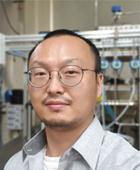
CO2 Laser 열탄소환원공정을 이용한 실리콘 나노입자 생산기술 개발
Abstract
Silica is the most readily available and the cheapest silicon material on Earth. Silicon shows excellent performance in many fields such as semiconductors and solar cells, and is currently a key material in industry. Although an electric arc furnace is used for mass production of silicon, there are critical disadvantages that need to be resolved. In this paper, we propose a CO2 laser-assisted carbothermal reduction process that incorporates a laser beam as an energy source. This process can successfully reduce silica to silicon, and the products are dry nanopowders that are easy to handle. We analyzed the characteristics of the nanoparticles produced through Raman spectroscopy and electron microscopy analysis. In addition, we present the production yield and energy efficiency through a quantitative analysis for the first time.
Keywords:
Silica, Silicon, Sand to silicon, Carbothermal reduction, CO2 laserAcknowledgments
본 연구는 한국연구재단 연구비 지원으로 수행된 연구입니다(2017R1C1B2011606, 2021R1I1A3059984).
References
-
Nordberg, R., Brecht, H., Albridge, R. G., Fahlman, A., Van Wazer, J. R., 1970, Binding Energy of the “2p” Electrons of Silicon in Various Compounds, Inorg. Chem., 9:11 2469-2474.
[https://doi.org/10.1021/ic50093a018]

-
Allendorf, M. D., Melius, C. F., Ho, P., Zachariah, M. R., 1995, Theoretical Study of the Thermochemistry of Molecules in the Si-OH System, J. Phys. Chem., 99:41 15285-15293.
[https://doi.org/10.1021/j100041a052]

-
Furgal, J. C., Lenora, C. U., 2019, Green Routes to Silicon-based Materials and their Environmental Implications, Phys. Sci. Rev., 5:1 20190024.
[https://doi.org/10.1515/psr-2019-0024]

-
Dal Martello, E., Tranell, G., Gaal, S., Raaness, O. S., Tang, K., Arnberg, L., 2011, Study of Pellets and Lumps as Raw Materials in Silicon Production from Quartz and Silicon Carbide, Metall. Mater. Trans. B, 42 939.
[https://doi.org/10.1007/s11663-011-9529-y]

-
Chigondo, F., 2018, From Metallurgical-grade to Solar-grade Silicon: An overview, Silicon, 10 789-798.
[https://doi.org/10.1007/s12633-016-9532-7]

-
Nguyen, T. T., Fukaya, N., Sato, K., Choi, J. -C., Kataoka, S., 2018, Technoeconomic and Environmental Assessment for Design and Optimization of Tetraethyl Orthosilicate Synthesis Process, Ind. Eng. Chem. Res., 57:6 2192-2199.
[https://doi.org/10.1021/acs.iecr.7b03895]

-
Goodrich, A., Hacke, P., Wang, Q., Sopori, B., Margolis, R., James, T. L., Woodhouse, M., 2013, A Wafer-based Monocrystalline Silicon Photovoltaics Road Map: Utilizing Known Technology Improvement Opportunities for Further Reductions in Manufacturing Costs, Sol. Energy Mater. Sol. Cells, 114 110-135.
[https://doi.org/10.1016/j.solmat.2013.01.030]

-
Fu, R., James, T. L., Woodhouse, M., 2015, Economic Measurements of Polysilicon for the Photovoltaic Industry: Market Competition and Manufacturing Competitiveness, IEEE J. Photovolt., 5:2 515-524.
[https://doi.org/10.1109/JPHOTOV.2014.2388076]

-
Louwen, A., Van Sark, W., Schropp, R., Faaij, A., 2016, A Cost Roadmap for Silicon Heterojunction Solar Cells, Sol. Energy Mater. Sol. Cells, 147 295-314.
[https://doi.org/10.1016/j.solmat.2015.12.026]

-
Ye, K., Wang, J., Xing, P., Du, X., Gao, B., Kong, J., Luo, X., 2019, Study of the Preparation of High Purity Silicon by a New Electro-thermal Metallurgy Method, Silicon, 11 1175-1184.
[https://doi.org/10.1007/s12633-017-9679-x]

-
Chan, C. K., Peng, H., Liu, G., McIlwrath, K., Zhang, X. F., Huggins, R. A., Cui, Y., 2008, High-performance Lithium Battery Anodes using Silicon Nanowires, Nat. Nanotechnol., 3 31-35.
[https://doi.org/10.1038/nnano.2007.411]

-
Hertzberg, B., Alexeev, A., Yushin, G., 2010, Deformations in Si− Li Anodes upon Electrochemical Alloying in Nano-confined Space, J. Am. Chem. Soc., 132:25 8548-8549.
[https://doi.org/10.1021/ja1031997]

-
Cui, L.-F., Hu, L., Wu, H., Choi, J. W., Cui, Y., 2011, Inorganic Glue Enabling High Performance of Silicon Particles as Lithium Ion Battery Anode, J. Electrochem. Soc., 158:5 A592.
[https://doi.org/10.1149/1.3560030]

-
Wu, H., Cui, Y., 2012, Designing Nanostructured Si Anodes for High Energy Lithium Ion Batteries, Nano Today, 7:5 414-429.
[https://doi.org/10.1016/j.nantod.2012.08.004]

-
Nohira, T., Yasuda, K., Ito, Y., 2003, Pinpoint and Bulk Electrochemical Reduction of Insulating Silicon Dioxide to Silicon, Nat. Mater., 2 397-401.
[https://doi.org/10.1038/nmat900]

-
Maeng, S. -H., Lee, H., Park, M. S., Park, S., Jeong, J., Kim, S., 2020, Ultrafast Carbothermal Reduction of Silica to Silicon using a CO 2 Laser Beam, Sci. Rep., 10 21730.
[https://doi.org/10.1038/s41598-020-78562-1]

-
Yue, G., Lorentzen, J. D., Lin, J., Han, D., Wang, Q., 1999, Photoluminescence and Raman Studies in Thin-film Materials: Transition from Amorphous to Microcrystalline Silicon, Appl. Phys. Lett., 75:4 492-494.
[https://doi.org/10.1063/1.124426]

-
Saleh, R., Nickel, N. H., 2003, Raman Spectroscopy of B-doped Microcrystalline Silicon Films, Thin Solid Films, 427:1-2 266-269.
[https://doi.org/10.1016/S0040-6090(02)01203-8]

-
Paillard, V., Puech, P., Laguna, M. A., Carles, R., Kohn, B., Huisken, F, 1999, Improved One-phonon Confinement Model for an Accurate Size Determination of Silicon Nanocrystals, J. Appl. Phys., 86:4 1921-1924.
[https://doi.org/10.1063/1.370988]

-
Laine, R. M., Furgal, J. C., Doan, P., Pan, D., Popova, V., Zhang, X., 2016, Avoiding Carbothermal Reduction: Distillation of Alkoxysilanes from Biogenic, Green, and Sustainable Sources, Angew. Chem.-Int. Edit., 128:3 1077-1081.
[https://doi.org/10.1002/ange.201506838]

-
Miller, P. D., Lee, J. G., Cutler, I. B., 1979, The Reduction of Silica with Carbon and Silicon Carbide, J. American Ceram. Soc., 62:3‐4 147-149.
[https://doi.org/10.1111/j.1151-2916.1979.tb19041.x]

- Fei, L., 2017, SiC Production Using SiO2 and C Agglomerates, Doctoral Dissertation, Norwegian University of Science and Technology (NTNU), Norway.
- Mølnås, H., 2010, Investigation of SiO Condensate Formation in the Silicon Process, Project report in TMT 4500, Norwegian University of Science and Technology (NTNU), Norway.
- Michal, K., Kero, I., Wittgens, B., 2015, Challenges in Transporting the Off-Gases from the Silicon Process, 2015-Sustainable Industrial Processing Summit (SIPS 2015) Vol. 3: Takano Intl. Symp. / Metals & Alloys Processing, 157-166.
- Ringdalen, E., Tangstad, M., 2016, Phase Transformations in Quartz and it's Effect on Furnace Operation, Silicon Chem. Sol. Ind. XIII, Kristiansand, Norway.

Graduate Student in the Department of Mechanical Design Engineering, Kangwon National University.
His research interest is carbothermal reduction of silica
E-mail: kinv13@naver.com

Undergraduate Student in the Department of Mechanical Design Engineering, Kangwon National University.
His research interest is designing of mechanical system.
E-mail: lsh961204@gamil.com

Professor in the Department of Mechanical Design Engineering, Kangwon National University.
His research interest is production of nanoparticles and its applications.
E-mail: sbkim81@kangwon.ac.kr